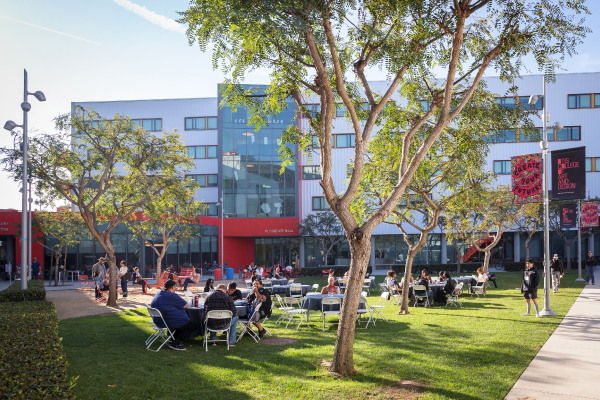Otis College of Art and Design prepares a diverse community of creative students for success and to lead transformation across the creative economy.
A leader in art and design education for over 100 years, Otis College distinguishes itself by offering one of the nation’s most diverse creative student bodies unparalleled access to art and design education, experiences, and industry.
Our community of students, alumni, faculty, and staff makes transformative contributions industries and communities. Building on that foundation, the 2025-2029 Strategic Plan aligns with our mission and reflects our commitment to academic excellence, career readiness, and community. Structured around five guiding principles, the plan outlines our goals for sustainable growth and impact.

Goals and Guiding Principles
Otis College of Art and Design has made significant advances over the past five years, including on matters listed below. This overview of the 2025–2029 Strategic Plan highlights the areas we commit to emphasizing over the next five years, charting a vision for the College that will continue its ascent within the art and design education field.
This strategic plan is structured around five Guiding Principles that represent perennial areas of emphasis for the institution. They reflect overarching themes that emerged throughout the planning process: belonging, sustainable growth, and excellence. By focusing on these Guiding Principles over the next five years we intend to continue the College’s upward trajectory in relation to admissions, retention, and careers.
Goal 1
Provide holistic enrollment, academic, and co-curricular support for prospective and continuing students.
Goal 2
Foster a culture of belonging and engagement among students, faculty, and staff.
Goal 3
Equip students and alumni with the skills, resources, and networks necessary to pursue their professional and creative ambitions.
Goal 1
Cultivate a curious and driven pool of prospective creative students. Attract and retain highly qualified faculty and staff.
Goal 2
Assess and prioritize institutional learning outcomes and interdisciplinary initiatives.
Goal 3
Expand engagement with industry among students and alumni.
Goal 1
Grow the college’s reputation among prospective students, art and design communities, and culturally engaged Angelenos.
Goal 2
Strengthen industry and alumni engagement through communications, partnerships, research, and activations.
Goal 1
Grow revenue from enrollment and alternative sources including housing, grants, and fundraising.
Goal 2
Assess and support scholarship programs as well as basic-needs resources and services.
Goal 1
Plan for new facilities to create a safe and welcoming environment that contributes to the community’s success and well-being.
Goal 2
Upgrade facilities and systems to meet curricular, co-curricular, technology, accessibility, and sustainability goals.

Mission Statement
Otis College of Art and Design educates a diverse community of creative and talented students, preparing them to become highly skilled, well-informed, and socially responsible professionals—empowering them to shape the world around them.

Educational Vision Statement
Through its commitment to a fully inclusive and career-oriented education, Otis College of Art and Design prepares a diverse community of emerging artists and designers to become change-makers within creative fields, finding novel solutions to the challenges of the 21st century.
